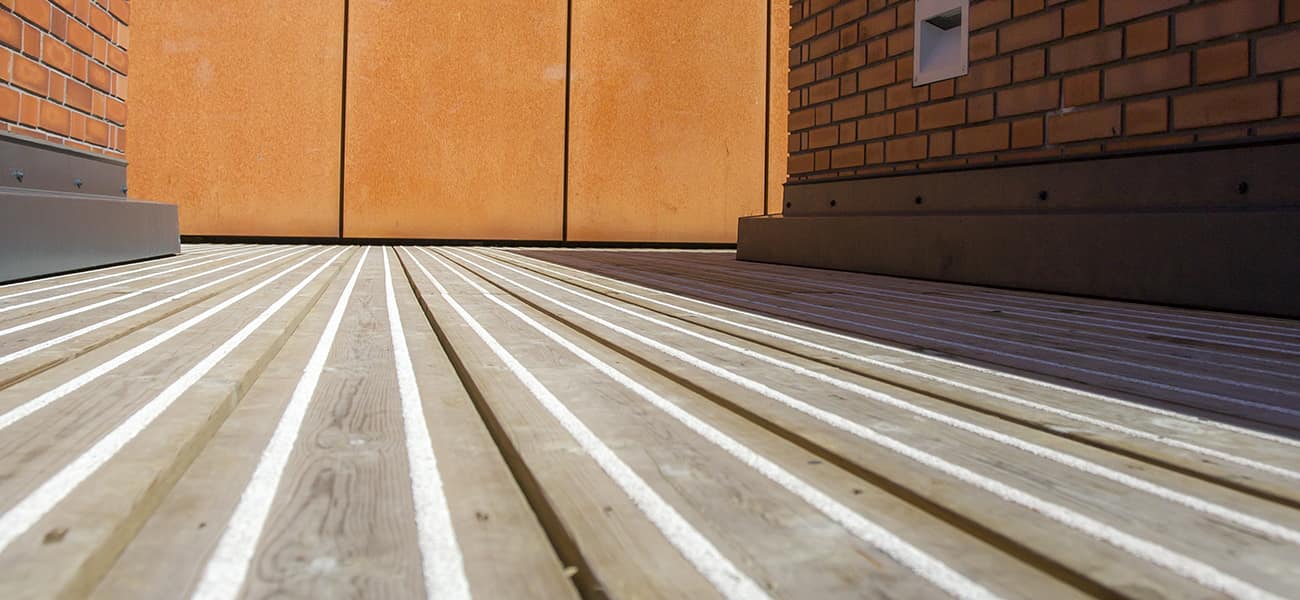When are Smooth Decking Boards Better than Castellated?

When are smooth deck boards better than castellated? And how do you know which decking product is the best choice?
Specifying grooved or smooth timber decking for a project will depend on several factors, including where it’s being installed, aesthetic preference, user comfort and ease of maintenance.
Castellated boards are often the first choice in the UK, due to their appearance often being preferred. But in most other countries, a smooth or flat profile is typically used for decking.
So, why are smooth boards preferred in other locations? They actually offer some practical benefits, which might make them a better choice - especially in busy areas with heavy footfall. You may also be surprised to learn that castellated boards don’t do much for slip resistance.
What are the benefits of smooth decking boards?
While grooved boards offer strong lines and a bold appearance, smooth timber decking can create a more even, natural-looking landscape. But it’s not just the aesthetics that set these two products apart. Smooth boards offer several significant practical advantages over grooved boards, including:
- A smooth ride - Smooth profile boards create an even deck surface that is more comfortable, creating a more inclusive environment for those using pushchairs, wheelchairs or bicycles.
- Heel-friendly - Smooth timber decking is easier to walk on when wearing heeled shoes. Grooved boards can be tricky to walk on in heels, with a potential for damage to both the shoes and the deck boards. This makes smooth boards particularly suited to busy public areas.
- Easier maintenance and cleaning - While all types of timber decking are low maintenance - they just need an occasional a sweep with a brush and an annual clean - smooth boards are often preferred in locations such as restaurants, bars and smoking areas. Food, litter, dirt and debris are less likely to become trapped in smooth boards than in grooved boards, making it much easier to keep the decking and maintain a high standard of hygiene.
Grooved does not mean anti-slip
It is a common mistake to think that castellated timber decking provides better anti-slip properties compared to smooth decking. It is thought that grooved deck boards were invented by a manufacturer who wanted to offer a decking profile that would offer improved grip for Britain’s rainy climate.
However, that idea has not proved to be accurate in practice. In fact, grooved boards offer no advantage over smooth in terms of slip resistance.
If you’re looking for slip resistance, boards with enhanced grip using anti-slip inserts - such as Marley Antislip Plus or CitiDeck - are recommended.
What are the benefits of grooved decking boards?
While smooth decking boards offer many advantages, there are also some compelling reasons to opt for grooved.
Water runoff:
Grooved boards can aid water runoff. This is only effective, however, if they are fitted with a slight fall and in short lengths. When boards are installed in longer lengths, the grooves may hold water. If longer lengths are preferred, a smooth profile could be the better choice.
The effectiveness of water runoff may also be reduced if the boards are not maintained properly, or if dirt and debris build-up within the grooves.
Grooved boards as a design feature:
Castellated decking is often chosen in the UK due to the aesthetic appeal of continuous and textured grooves.
If you think that smooth boards might be the better choice for your decking project, but don’t want to give up on grooved boards entirely, one option is to use both - saving the grooved boards for specific purposes or visual contrast.
Grooved boards can be interwoven with smooth deck boards to create attractive designs. They can also be placed in varying configurations to create changes of direction and to lead the eye into different areas of a landscape.
Grooved decking boards are also useful for creating contrasting design features to aid people with visual impairments. For example, the grooves can provide a tactile warning before steps, at the start and end of ramps and to indicate doorways.
Other applications include defining the edges of walkways to indicate the line of travel and breaking up large spaces by providing reference points for anybody disorientated by an open area.
A wide range of timber decking from Marley
So, which do you choose - smooth or castellated decking? The answer really is down to personal preference, and the best solution might be a combination of decking types. The right choice of profile can have a significant impact on the appearance and day-to-day use of your outdoor space, as well as ease of maintenance.
Marley offers a wide range of timber decking, with something to suit every requirement. Options include plain boards in both smooth and castellated profiles, as well as anti-slip products.
For more information on the types and uses of Marley decking, visit our timber decking section or contact our technical experts who will be happy to discuss your next project in detail.
Category: Decking Sustainability Timber